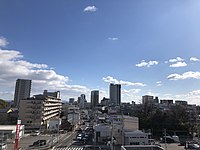|
Chiryū
Chiryū (知立市, Chiryū-shi) is a city in central Aichi Prefecture, Japan. It belongs to the Nishimikawa region. As of 1 October 2019[update], the city had an estimated population of 71,992 in 32,579 households,[1] and a population density of 4,414 persons per km². The total area of the city is 16.31 square kilometres (6.30 sq mi). Geography Chiryū is situated in central Aichi Prefecture bordered by the Aizuma River to the north and the Sawatari River to the south. ClimateThe city has a climate characterized by hot and humid summers, and relatively mild winters (Köppen climate classification Cfa). The average annual temperature in Chiryū is 15.7 °C. The average annual rainfall is 1579 mm with September as the wettest month. The temperatures are highest on average in August, at around 27.9 °C, and lowest in January, at around 4.3 °C.[2] DemographicsPer Japanese census data,[3] the population of Chiryū has been increasing steadily over the past 70 years.
Neighboring municipalitiesHistoryAncient history"Chiryū" as a local place name appears in documents in the Nara period, and was located within former Mikawa Province. Early modern periodDuring the Edo period, the area prospered as Chiryū-juku, one of the post stations on the Tōkaidō connecting Edo with Kyoto. The town was noted for its horse trading fairs. Part of the present day city were under the control of Kariya Domain, a feudal han under the Tokugawa shogunate. The pottery industry was developed in these area from ancient times to the Middle Ages. About 100 old kiln sites have been discovered to date, as well as many ponds for agriculture that are said to have been built up to the early modern period.[4] Late modern periodAfter the Meiji restoration, Chiryū Town was created within Hekikai District, Aichi Prefecture on 1 October 1889 with the establishment of the modern municipalities system. Contemporary historyChiryū attained city status on 1 December 1970. Government Chiryū has a mayor-council form of government with a directly elected mayor and a unicameral city legislature of 20 members. The city contributes one member to the Aichi Prefectural Assembly. In terms of national politics, the city is part of Aichi District 13 of the lower house of the Diet of Japan. EconomyThe economy of Chiryū is industrial, with automotive parts and automotive electronics manufacturing predominating. Fuji Corporation, a machine tool manufacturer, has its head office and factory in Chiryū. The city has numerous road and rail connections to downtown Nagoya and is increasingly becoming a commuter town. EducationSchoolsChiryū has seven public elementary schools and three public middle schools operated by the city government, and two public high schools operated by the Aichi Prefectural Board of Education. There is also one private high school and three private vocational training schools. TransportationRailwaysConventional lines
RoadsJapan National RouteLocal attractions
The Kikatsubata is the prefectural flower of Aichi prefecture as well as of Chiryū City. Each year at the end of April a festival is held in the temple garden as a celebration of the flowering. Sister cities
Notable people from Chiryū
References
External links
|
|||||||||||||||||||||||||||||||||||||||||||||||||||||||||||||||||||||||||




